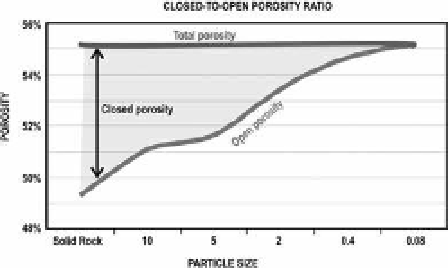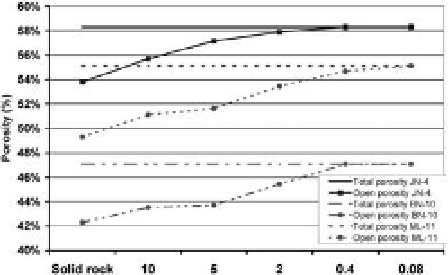Environmental Engineering Reference
In-Depth Information
Finally the closed porosity results from the
difference between total and open porosity
V
V
V
VV
γγ
γ
cp
cp
s
s ap
,
(4)
n
=
=
=
skel
+
skel
s
cp
s
(3)
n
=
n
−
n
closed
total
open
3.4
Results and interpretation
Taking as an example the sample Ml-11, helium
pycnometry results and porosity calculations are
summarized in Table 1 and shown in Figure 6.
There is a close connection between the lapilli
particle size and the open and closed porosity, and
this trend is present the tree representative samples
(
Fig. 7
) and can be attributable to the fact that
closed porosity decreases when the particle size
also decreases.
alternatively, another way of expressing the closed
porosity is relating the total closed pores volume
not to the total volume but to the skeleton volume,
being the skeleton volume the sum of solid volume
and the closed pores volume (
V
skel
=
V
s
+
V
cp
).
Table 1.
helium pycnometry results for sample Ml-11.
Particle
size (mm)
Rock <10
<5.0
<2.0 <0.4
<0.08
3.04
=
3.04
=
3.04
γ
s
=
4
GeoTechnical PaRaMeTeRs
anD BehaVioUR
γ
d
1.364 =
1.364 =
1.364 =
γ
skel
2.69
2.79
2.82
2.93
3.01
3.04
n
total
(%)
55.1
55.1
55.1
55.1
55.1
55.1
n
open
(%)
49.3
51.1
51.6
53.4
54.7
55.1
Basaltic lapilli are the most common type of
lapilli. Table 2 shows their weight-volume rep-
resentative values and Table 3 their geotechnical
properties.
The principal conclusions are the following:
1. lapilli, as a whole, are essentially a granular
material with high angles of friction (34-37º)
2. The values of unconfined compressive strength
(
qu
) are relatively high, but usual bearing capac-
ity (
q
) values used for superficial foundation
design are low, about 100 to 200 kPa.
3. high slope angles (even a 1h/5V relation) are
stable in the short term because of the high
irregularity of the particles, together with a cer-
tain degree of welding or cementation; however,
in the long term and as a result of superficial
erosion, the slope angles decrease consider-
ably and even reach the angle of repose. in this
n
closed
(%)
5.8
4.0
3.5
1.7
0.4
0.0
n
skel
(%)
11.5
8.2
7.2
3.6
1.0
0.0
= constant value.
Figure 6. Relationship between particle size and closed-
to-open porosity ratio.
Table 2.
Unit weight values of basaltic lapilli.
Parameter
sample place
Values, kn/m
3
specific gravity,
G
General
(1)
22.17-29.3
canary is.
(2)
25.1-27.2
Dry unit weight,
γ
d
canary is.
(3)
11.87-12.16
Gran canaria
(4)
7.94-9.51
canary is.
(5)
7.8-10.4
Moist unit weight,
γ
lanzarote
(6)
10.86-15.77
Gran canaria
(2)
12.26-16.38
saturated unit
weight,
γ
sat
canary is.
(3)
20.79-24.13
(1)
Blyth and de Freitas (1984),
(2)
iGMe (1974a),
(3)
iGMe
(1974b),
(4)
enaDiMsa, unpubl.,
(5)
serrano et al. (2002),
(6)
Ministerio de agricultura, unpubl.
Figure 7. Relationship between particle size and close-
to-open porosities in the three lapilli samples.






























